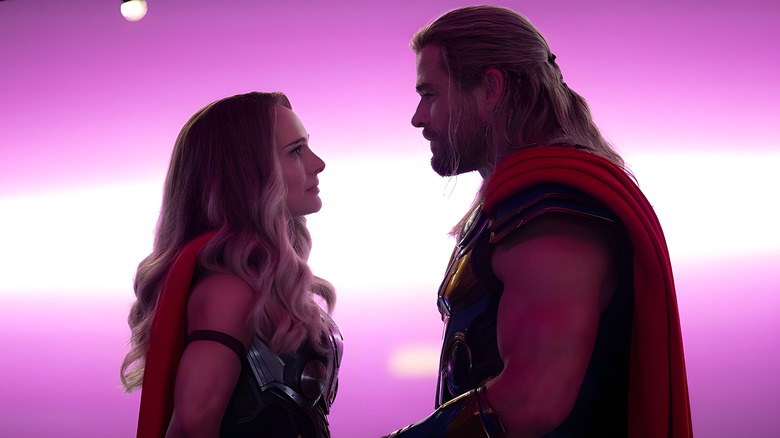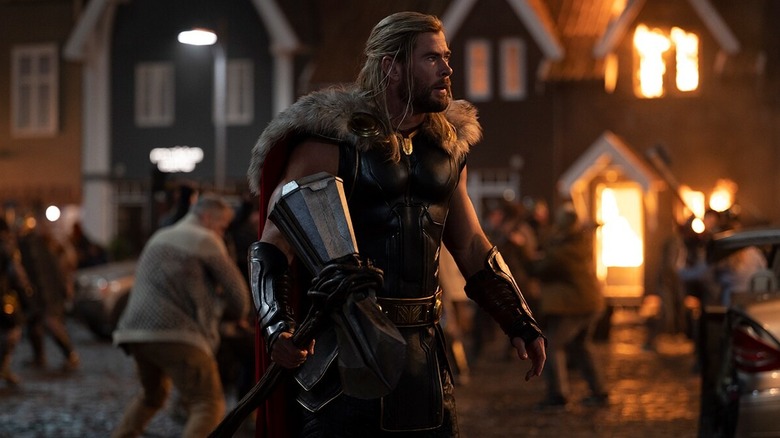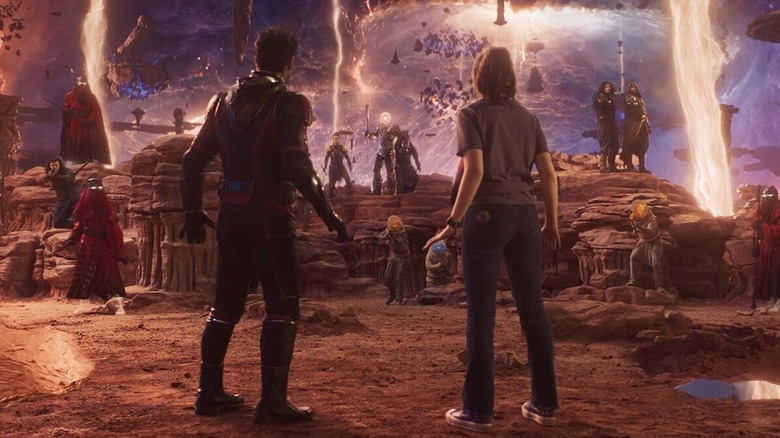Marvel Movies Might Look Really Different After This Huge Special Effects Change
It's easy to assume that, much like the heroes they've helped create over the years, there is nothing that the visual effects teams behind the Marvel Cinematic Universe can't achieve on screen. But even with Marvel's seemingly endless resources, technological limitations have given these departments their fair share of difficulties. But a new process taking the industry by storm is finally catching up with the MCU — and it seems like it's going to stay.
Starting with 2022's "Thor: Love and Thunder," and followed by "Ant-Man and the Wasp: Quantumania," Marvel Studios employed The Volume, a state-of-the-art manner of shooting actors against digital backgrounds. In the past, performers would act against blue or green screens before any effects work was complete, meaning that they and the crew would have to imagine what they'd be interacting with. This method made it hard to predict entirely how a scene would look in the final product, as one section wouldn't be implemented until months later.
Many of these issues are being resolved with The Volume and similar virtual production technology. This new system sees actors surrounded by 360-degree LED screens that present the partially-rendered environments they will be working against in real time. At the same time, directors are able to make fine-tuned adjustments to the lighting and perspective. The process allows for a far more seamless interaction between performers and the visual effects elements than ever before. All throughout the industry, these new tools are receiving praise, and not only from directors or VFX artists.
Actors are fans of the new process
Marvel's recent cinematic efforts are far from the first to utilize The Volume. While early examples of virtual technology, such as StageCraft, could be seen in films such as 2013's "Oblivion" and 2016's "Rogue One: A Star Wars Story," the tech received widespread attention after its use in the first season of "The Mandalorian." Since then, virtual production has been used on everything from "The Batman" to "How I Met Your Father," proving its wide range of capabilities.
In whatever case virtual production is used, actors have benefited from its many merits, and the stars of the MCU are no exception. When speaking with Disney in 2022 about his experience while making "Thor: Love and Thunder," Chris Hemsworth described how shooting in such a style enhanced his skills as a performer. "If you're standing on the edge of a cliff looking out at a sunset, to actually be staring into a sunset certainly pulls out emotions and reactions that you may not get using a blue or green screen," he stated.
Given that The Volume also allows for more precise visual elements, the "Extraction" star was equally delighted to finally be immersed in the fantasy worlds he's been acting against for over a decade now. He continued, "It's visually stunning because you get the actual reflection off the background, a nice orange glow on your skin from the sun. It's a beautiful interaction that occurs." Even despite these advancements, filmmakers still see new avenues for virtual production.
Virtual production still has its limits
While virtual production has given filmmakers unprecedented freedom when constructing visual effects sequences, even this tool has limitations. This lesson was learned by "Ant-Man and the Wasp: Quantumania" director Peyton Reed, who soon discovered that The Volume wasn't always the best choice when shooting his film.
Reed is no stranger to using this technique, having helmed two episodes of "The Mandalorian" Season 2. However, as work began on his third Marvel feature, Reed and company quickly discovered that even The Volume could only partially contain the expansive world of Quantum Realm. "We ended up using the Volume technology, [and] it was great for certain environments, but not necessarily right for other ones," Reed commented in an interview with Collider. "Sometimes our sets are too big for the Volume, so we would use partial sets." Reed believed that while "The Mandalorian" benefited from photo-real locations and backdrops, his eccentric vision for "Quantumania" made it more tricky to incorporate volume technology. Nevertheless, he added that, even with its setbacks, the system was loved by the actors and allowed for a unique quality to several scenes.
The Volume still has some ways to go before being considered the full-on industry standard, but it's already taking some mind-blowing steps forward. And as the MCU continues to build its ever-expanding world, the technology is sure to become a mainstay for Marvel's effects-heavy productions.


